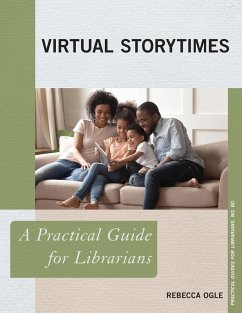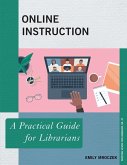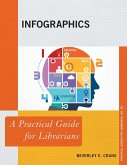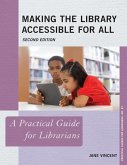- Broschiertes Buch
- Merkliste
- Auf die Merkliste
- Bewerten Bewerten
- Teilen
- Produkt teilen
- Produkterinnerung
- Produkterinnerung
This is the first book to provide practical guidance for library staff on virtual storytime planning and production. It includes case studies, tips, and resources.
Andere Kunden interessierten sich auch für
![Online Instruction Online Instruction]() Emily MroczekOnline Instruction83,99 €
Emily MroczekOnline Instruction83,99 €![Infographics Infographics]() Beverley E. CraneInfographics106,99 €
Beverley E. CraneInfographics106,99 €![Making the Library Accessible for All Making the Library Accessible for All]() Jane VincentMaking the Library Accessible for All77,99 €
Jane VincentMaking the Library Accessible for All77,99 €![Working Remotely Working Remotely]() Molly VirelloWorking Remotely83,99 €
Molly VirelloWorking Remotely83,99 €![Simple Positive Play at the Library Simple Positive Play at the Library]() Jennifer IlardiSimple Positive Play at the Library100,99 €
Jennifer IlardiSimple Positive Play at the Library100,99 €![Piecing Together Systematic Reviews and Other Evidence Syntheses Piecing Together Systematic Reviews and Other Evidence Syntheses]() Piecing Together Systematic Reviews and Other Evidence Syntheses107,99 €
Piecing Together Systematic Reviews and Other Evidence Syntheses107,99 €![The Safe Library The Safe Library]() Steve AlbrechtThe Safe Library48,99 €
Steve AlbrechtThe Safe Library48,99 €-
-
-
This is the first book to provide practical guidance for library staff on virtual storytime planning and production. It includes case studies, tips, and resources.
Hinweis: Dieser Artikel kann nur an eine deutsche Lieferadresse ausgeliefert werden.
Hinweis: Dieser Artikel kann nur an eine deutsche Lieferadresse ausgeliefert werden.
Produktdetails
- Produktdetails
- Practical Guides for Librarians
- Verlag: Rowman & Littlefield
- Seitenzahl: 156
- Erscheinungstermin: 15. August 2022
- Englisch
- Abmessung: 280mm x 216mm x 9mm
- Gewicht: 412g
- ISBN-13: 9781538158500
- ISBN-10: 1538158507
- Artikelnr.: 63459485
- Herstellerkennzeichnung
- Libri GmbH
- Europaallee 1
- 36244 Bad Hersfeld
- gpsr@libri.de
- Practical Guides for Librarians
- Verlag: Rowman & Littlefield
- Seitenzahl: 156
- Erscheinungstermin: 15. August 2022
- Englisch
- Abmessung: 280mm x 216mm x 9mm
- Gewicht: 412g
- ISBN-13: 9781538158500
- ISBN-10: 1538158507
- Artikelnr.: 63459485
- Herstellerkennzeichnung
- Libri GmbH
- Europaallee 1
- 36244 Bad Hersfeld
- gpsr@libri.de
By Rebecca Ogle
Preface
Chapter 1: Choosing A Virtual Format
Identifying audiences and developing goals
Synchronous versus asynchronous storytimes
Exploration of virtual formats
Chapter 2: Technological Considerations
Hardware requirements and recommendations for library staff and patrons
Accessibility best practices
Web conferencing software features
Image, presentation, and video software features
File storage and organization
Chapter 3: Legal Issues
Privacy Laws
Storytime and Fair Use
Public domain and original content
Creative Commons and attribution
Copyright and permissions
Avoiding issues with copyright algorithms
Chapter 4: Planning and Preparation
Planning: Now With More Technology
Production quality tips
Planning interactive virtual storytimes
Book and media selection
Preparing outlines and scripts
Chapter 5: Showtime
Strategies for common challenges
Best practices during synchronous storytimes
Best practices for recording
Finishing touches in editing
Chapter 6: Engaging Staff
Key competencies for virtual storytime staff
Screen time and media mentorship
Training for virtual storytime
Avoiding and addressing staff burnout
Chapter 7: Outreach and Promotion
Creating meaningful partnerships
The marketing funnel
Digital marketing best practices
Social media engagement methods
Appendix A: Software and Websites for Content Creators
Appendix B: Case Study: Read With Us TV Series
Appendix C: Case Study: Daniel Tiger Storytime on Facebook Live
Appendix D: Sample Outline, Script, and Reflection
Chapter 1: Choosing A Virtual Format
Identifying audiences and developing goals
Synchronous versus asynchronous storytimes
Exploration of virtual formats
Chapter 2: Technological Considerations
Hardware requirements and recommendations for library staff and patrons
Accessibility best practices
Web conferencing software features
Image, presentation, and video software features
File storage and organization
Chapter 3: Legal Issues
Privacy Laws
Storytime and Fair Use
Public domain and original content
Creative Commons and attribution
Copyright and permissions
Avoiding issues with copyright algorithms
Chapter 4: Planning and Preparation
Planning: Now With More Technology
Production quality tips
Planning interactive virtual storytimes
Book and media selection
Preparing outlines and scripts
Chapter 5: Showtime
Strategies for common challenges
Best practices during synchronous storytimes
Best practices for recording
Finishing touches in editing
Chapter 6: Engaging Staff
Key competencies for virtual storytime staff
Screen time and media mentorship
Training for virtual storytime
Avoiding and addressing staff burnout
Chapter 7: Outreach and Promotion
Creating meaningful partnerships
The marketing funnel
Digital marketing best practices
Social media engagement methods
Appendix A: Software and Websites for Content Creators
Appendix B: Case Study: Read With Us TV Series
Appendix C: Case Study: Daniel Tiger Storytime on Facebook Live
Appendix D: Sample Outline, Script, and Reflection
Preface
Chapter 1: Choosing A Virtual Format
Identifying audiences and developing goals
Synchronous versus asynchronous storytimes
Exploration of virtual formats
Chapter 2: Technological Considerations
Hardware requirements and recommendations for library staff and patrons
Accessibility best practices
Web conferencing software features
Image, presentation, and video software features
File storage and organization
Chapter 3: Legal Issues
Privacy Laws
Storytime and Fair Use
Public domain and original content
Creative Commons and attribution
Copyright and permissions
Avoiding issues with copyright algorithms
Chapter 4: Planning and Preparation
Planning: Now With More Technology
Production quality tips
Planning interactive virtual storytimes
Book and media selection
Preparing outlines and scripts
Chapter 5: Showtime
Strategies for common challenges
Best practices during synchronous storytimes
Best practices for recording
Finishing touches in editing
Chapter 6: Engaging Staff
Key competencies for virtual storytime staff
Screen time and media mentorship
Training for virtual storytime
Avoiding and addressing staff burnout
Chapter 7: Outreach and Promotion
Creating meaningful partnerships
The marketing funnel
Digital marketing best practices
Social media engagement methods
Appendix A: Software and Websites for Content Creators
Appendix B: Case Study: Read With Us TV Series
Appendix C: Case Study: Daniel Tiger Storytime on Facebook Live
Appendix D: Sample Outline, Script, and Reflection
Chapter 1: Choosing A Virtual Format
Identifying audiences and developing goals
Synchronous versus asynchronous storytimes
Exploration of virtual formats
Chapter 2: Technological Considerations
Hardware requirements and recommendations for library staff and patrons
Accessibility best practices
Web conferencing software features
Image, presentation, and video software features
File storage and organization
Chapter 3: Legal Issues
Privacy Laws
Storytime and Fair Use
Public domain and original content
Creative Commons and attribution
Copyright and permissions
Avoiding issues with copyright algorithms
Chapter 4: Planning and Preparation
Planning: Now With More Technology
Production quality tips
Planning interactive virtual storytimes
Book and media selection
Preparing outlines and scripts
Chapter 5: Showtime
Strategies for common challenges
Best practices during synchronous storytimes
Best practices for recording
Finishing touches in editing
Chapter 6: Engaging Staff
Key competencies for virtual storytime staff
Screen time and media mentorship
Training for virtual storytime
Avoiding and addressing staff burnout
Chapter 7: Outreach and Promotion
Creating meaningful partnerships
The marketing funnel
Digital marketing best practices
Social media engagement methods
Appendix A: Software and Websites for Content Creators
Appendix B: Case Study: Read With Us TV Series
Appendix C: Case Study: Daniel Tiger Storytime on Facebook Live
Appendix D: Sample Outline, Script, and Reflection








